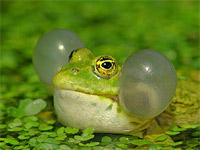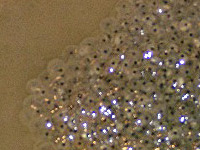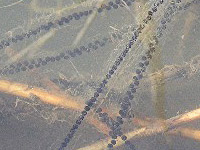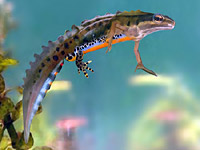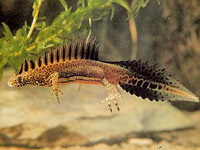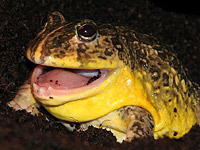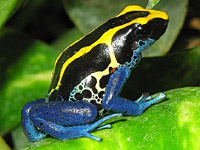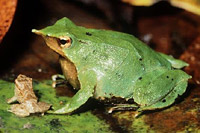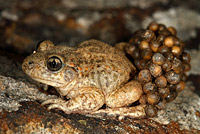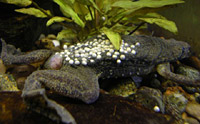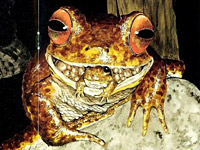Amphibians
Amphibios, translated from Greek, means “living double life”. Amphibians are animals who adapted to living both on land and in water. It is this feature that makes them unusual.
It is generally recognized that they originated from lobe-finned fishes and gave birth to reptiles.
Usually, modern amphibians are classified into three orders:
The most numerous order comprises tailless amphibians (Anura) — frogs, toads, etc. — more than 5000 species in total.
They have a short body without a tail, almost no neck, and well-developed legs. Their hind legs are strong, 2-3 times larger than front ones and allow moving in leaps.
Salamanders (Caudata) — tailed amphibians — is another group, which comprises about 500 species. Their main distinctive features are an elongated body, a long tail, and short, usually weak legs. Only few terrestrial salamanders can run quickly, like lizards, or even jump.
The third group is Caecilians (Gymnophiona or Apoda) — limbless amphibians. This group comprises amphibians resembling worms or snakes. They lack legs and have a more primitive body structure compared to other amphibians.
Habitat
These naked (i.e. lacking hair or other heat-preserving coverings) creatures are found in areas of quite diverse climatic conditions — they inhabit all continents except for Antarctica. Amphibians mastered very hard living conditions: for example, salt water reservoirs, dry and very cold areas. They occur in the Himalayas at the altitude of 4500 m, in deserts, underground, within the Arctic and Antarctic Circles. Of course, the majority of amphibian species occur in the tropical region — where it is warm and wet, and there is abundant food.
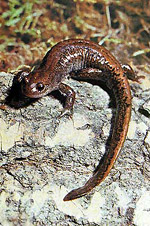
Siberian salamander
The high resistance to cold of some amphibians allows them to live even in the northernmost habitable areas. For example, throughout Siberia — from the Urals to the Pacific — occurs the Siberian salamander (Hynobius keyserlingi). Living in the conditions of permafrost, this newt can survive the temperature of –20°C in wild and –30°C in experimental conditions. Geologists found these amphibians in the fossil ice of permafrost, where Siberian salamanders would spend tens of years! Yet, it was enough for a frozen Siberian salamander to thaw and warm, and it would begin to catch flies and spiders, as if nothing had happened! How can Siberian salamanders survive, frozen to ice? The fact is that at the temperature below zero degrees Celsius, the water in the Siberian salamander’s cells is replaced with glycerin which has a low freezing point and thus prevents cell death.
Some tailless amphibians are also capable of living within the Arctic Circle. They can survive low temperatures thanks to remarkable components of the blood, which can be likened to well-known to drivers “antifreeze”.
It is quite interesting: what happens to the souls of such animals in the state of hibernation during long wintertime? Most likely, they detach from their material bodies and stay somewhere near the body or in the places of accumulation of such souls. There fore, this phenomenon is somewhat like clinical death. When the conditions change to favorable for living activity of the bodies — the souls return into them.
Miraculous Legs of Tailless Amphibians
The amphibians’ limbs are created so that they work well both in water and on land. Their front legs differ much from those of other tetrapods. They even hardly can be called legs: they are more similar to child’s arms! Yet, these remarkable limbs help the animal not only to move on land, but also to climb on trees, to dig into the ground, to construct nests, etc.
The legs of tailless amphibians are equipped with numerous useful add-ons: sucker disks, glands secreting sticky substances for clinging to various kinds of surfaces, soft pads for reducing the shock when landing after a jump, hard “calluses” for digging, webs between the digits to aid swimming, etc.
* * *
Let us review some examples of how amphibians move.
Toads have short front legs and move on land in small leaps or by walking.
A characteristic feature of frogs is long hind legs with webbed digits. These legs allow them to swim and leap well. Thanks to well-developed muscles of the hind legs, a frog can jump very high. It lands first on the front feet equipped with soft pads for reducing the shock of landing and then — on the hind feet. The black-spotted tree frog (Hyla nigromaculata), whose body length is 30mm can jump one and a half meters. The agile frog (Rana dalmatina) can perform three-meter jumps.
* * *
Many species of amphibians are capable of burying themselves quickly in the ground. For this purpose, they have special horny outgrowths on the feet. For example, the common spadefoot (Pelobates fuscus) hunts at night and during the daytime it stays in the ground whereto it buries itself. The common spadefoot does it very skillfully: in less than one minute it can bury itself in sand or loose ground. In this way, these inhabitants of deserts hide from heat of the day.
Some amphibians living in deserts can stay in the sand for a long time, without going to the surface during long droughts. In this state, the metabolism in their organisms slows down, and they can stay without food for a long time.
* * *
Representatives of some tree frog species spend significant part of their lives in another unique environment — in crowns of trees. These small and agile amphibians have a remarkable complex of gadgets for performing masterly jumps. On the tips of their toes, there are special disks which act like suckers. Moreover, special glands on these disks secrete sticky liquid. Thanks to them, tree frogs can cling to the smooth surface of a trunk, branch, leaf, can walk over a smooth wall of a building and even hang upside down on it.
Leaf-frogs (Phyllomedusa) can oppose the first digit to others — like monkeys! Thanks to this, the leaf-frog easily grasps branches and holds on to them tight. Curiously enough, these animals resemble monkeys-sloths walking slowly and as if lazily through crowns of trees.
Old World tree frogs (Polypedatidae), also living on trees, are known for their ability to perform sliding jumps; they are even called “flying frogs”. Between digits of their hind and front legs, there are well developed webbings. When the frog jumps, it stretches the digits, inflates the body, and easily slides down. On the end of their digits, there are extended disks. Malabar flying frogs, which belong to of this family, perform 9-12 meters sliding jumps.
* * *
Tailless amphibians move in water by pushing their powerful webbed hind legs through the water. Their makeup is so convenient, that people used it when creating flippers. The front legs, during swimming, are pressed against the body.
How Do Amphibians Breathe?
As inhabitants of both land and water, amphibians have a universal respiratory system. It allows obtaining oxygen not only from air but also from water (though its concentration in water is ten times less). Such universality is possible only thanks to a whole complex of respiratory organs for obtaining oxygen from that environment where the animal stays in the current moment.
While amphibians stay in water, they breathe through the skin, but as soon as they come to the land (or to the surface of the water reservoir) they begin to use the respiratory system of lungs and mouth’s mucous membrane. But even when the lungs are used, the organism can obtain up to 50% of the needed oxygen and let out up to 70% of the carbon dioxide through the skin. However, this is possible only if the skin is moist. For moistening the skin there are special skin glands.
The fish’s gas exchange (taking in oxygen and letting out carbon dioxide) is accomplished mainly through gills. Larvae of amphibians (tadpoles) and adult tailed amphibians living in water also have gills.
There are also lungless salamanders — inhabitants of land — which have neither gills nor lungs! The take in oxygen and let out carbon dioxide only through the moist skin and mucous membrane of the mouth!
The edible frog, in water and on land obtains main amount of the oxygen though the skin and lets out through it almost all carbon dioxide. Additional respiration is provided by the lungs, but only on land.
Toads, in contrast to other tailless amphibians, are less dependent on the skin respiration thanks to more powerful lungs.
* * *
There is another wonderful feature of the amphibian’s organism. It has neither diaphragm nor ribs with their muscles, which help terrestrial animals to breathe. How does the lung respiration function in case of amphibians?
It turns out, that they transport air in and out of the lungs using the mouth cavity as a pump.
How do they inhale? The bottom of the mouth cavity moves down, and air is pulled in through the open nostrils; then the animal closes the nostrils and raises the bottom of the mouth to the palate — thus it forces air into the lungs through the larynx.
How Do Amphibians Drink?
We know now that amphibians can breathe in water through the skin. But with the help of skin they can also “drink”!
The skin of amphibians is very thin, resembling semi-transparent fabric. It easily lets water in and out, together with salts dissolved in it. Therefore, the water-salt balance of the organism is maintained through the skin. If there is too much water in the organism, its excess is sent out not only through the kidneys but also through the skin. If there is a deficit of water and the frog thirsts, it does not have to drink — it is enough for the frog to walk over grass with dew or to lie in a puddle. These unique animals absorb water into the body like blotting paper!
Coloration of the Skin
One of the peculiarities of the amphibian’s skin is protective coloration. In particular, the success of hunting depends on the ability to hide oneself.
In particular, the upper part of the body of the cameroon toad (Bufo superciliaris) resembles a fallen leaf, and the lower part looks like a deep shadow created by this leaf. This creates a perfect illusion when the toad sits on the ground covered with real leaves.
The majority of tropical amphibians have particularly bright colors: in this environment only bright coloration can camouflage the animal among the blossoms and lush greenness of the tropics.
The coloration of certain amphibian species can change as the coloration of chameleons, though more slowly. For example, common frogs can change the color from brownish-red — to almost black. These amazing abilities of the skin are thanks to presence in it of special pigment cells — chromatophores.
Skin Repellents
Amphibians are well protected from pathogens, mosquitoes, ticks, leeches by special components of the skin secretes. On their skin there are never parasites or lesions caused by microbes, viruses, or pathogenic fungi!
Molting
All amphibians undergo seasonal molts, replacing the entire skin.
For example, the marsh frog sheds the old skin in the following way. It rubs by the arms one eye, then — another eye, as if they itch. Then it rubs the sides. At that point, one can see the old semitransparent skin hanging from its body. The frog pushes it by the arms into the mouth and eats.
Can the Amphibian Skin Function as Eyes?
In addition to above said, the skin serves as a sensitive organ for perceiving the outer information.
For example, some amphibian species, even as fishes, have special organs of sense — neuromasts which are equipped with sensitive receptors.
These organs signal to the animal about displacements and vibrations in the water. They are useful for active location of the water space, especially in muddy water or at night, when they replace the vision.
For example, such organs are found in African clawed frogs (Xenopus laevis). They look like small hollows with microscopic hairs. These hairs bend when water moves along the body. In the nervous system corresponding signals occur. This remarkable system informs the frog about hardly noticeable displacements in the water caused by a swimming insect, for example.
Moreover, the amphibian’s skin has sensitivity to light. Due to this remarkable property, the skin is even considered as an element of the organs of vision of amphibians.
About Amphibian’s Eyes
The eyes of amphibians also can function in two environments: in air and in water.
Focusing is performed in the same way as in a camera: the lens moves along the optic axis of the eyeball toward or from the retina.
For protection of the eyes’ surface from drying, there are eyelids (upper and lower ones, and nictitating membrane). Some kinds of amphibians — mainly terrestrial ones — have also lachrymal glands.
It is interesting that frogs perceive by eyes moving objects only. Shrubs, trees, sky — they perceive as background.
How Do They Hear?
Amphibians hear very well. They can even hear the sounds which humans can not.
Where are their ears located?
Looking closely at a frog, one can spot behind the eyes, on the sides of the head, small circles covered with membrane. This membrane is the eardrum. People have it deep inside the acoustic duct; for most of amphibians, it is locate right outside. Sound waves spreading in air or in water cause it to vibrate; the membrane, in turn, transmits the signal through the auditory ossicle to the inner ear, where the auditory receptors are located. From the inner ear, neural impulses are transmitted to the brain where the auditory picture of the environment is formed.
However, not all amphibians have this kind of auditory system.
For instance, limbless amphibians tunneling in wet and warm soil of the tropics have “seismic” hearing and perceive vibration of the ground by the lower jaw; the sound is transmitted to the inner ear by the skull bones. It is the same with some tailed amphibians.
The Language of Smells in the World of Amphibians
Even as mammals, some amphibians use the language of smells for marking their territory and in mating.
For example, a salamander emanates special chemical substance when other representatives of the same species enter its territory; this substance signals that this territory is taken.
The banded newt leaves on underwater objects odorous marks which contain information to what sex and kind this specimen belongs. In breeding season, males find females with the help of such “marriage advertisements”.
Nutrition
Many amphibians have the possibility to eat well only during the period of abundance of the insects and other invertebrates they feed on. The rest of the time, their vital activity is supported by the fat deposits which they accumulated.
Salamanders, frogs, and toads hunt for insects on the ground. Tropical tree frogs and neotropical salamanders catch their prey on branches of trees and shrubs.
Edible frogs (Rana esculenta) forage in the daytime. However, their activity depends on the temperature, as it is with other amphibians. In the morning, when it is cold, they gather in large groups on leaves of water plants and warm themselves in the sun. When it becomes warmer, they go foraging.
Common and moor frogs and also toads prefer to hunt in evening and at night.
The hunting methods of amphibians are quite various.
A frog’s leap at high speed lasts 0.3 sec.
During the leap, the frog’s eyes are closed and drawn inside the eye-sockets — to avoid possible traumas. Only close to its prey, the frog stretches forward the arms, opens the eyes, very precisely adjusts movement of the body, and only then flips out its sticky tongue exactly at the target.
Some tree frogs perform their leaps so that, having caught the prey, in the end of the leap they land on a leaf or branch of tree.
Flash-like movement of the amphibian’s tongue cannot be seen by human eye. For example, the Italian cave salamander, having approached a prey, flips out its tongue in one hundredth of a second, the cane toad (Bufo marinus) — in 3 hundredths of a second, the american toad (Bufo americanus) — in 1.5 hundredths of a second.
How does the tongue of amphibian look like? It is attached not in the depth of the mouth, as it is with us, but near the chin. On its tip there is a deep hollow; the tongue itself is covered with mucus.
However, not all amphibians have such a tongue. African clawed frogs (Xenopus), Carvalho’s Surinam toads (Pipa carvalhoi) living in South America, Surinam toads (Pipa pipa) have no tongue at all. Fire-bellied toads (Bombinatoridae) cannot use the tongue for hunting: it is fat and resembles a disk (these amphibians even called disc-tongued). Therefore they have to catch the prey with the mouth.
Hibernation of Amphibians
Best of all live the amphibians which inhabit the areas with wet tropic climate, where it is warm all year round. In these conditions, they feel most comfortable — better than in any other place on the Earth.
In deserts and savannas, there may be no precipitation for several months. During this time, the life stands still. The amphibians living there, in order to preserve water in the organism, enter hibernation burying themselves deeply in sand or mud, hiding in burrows, under stones or roots of trees.
In temperate and northern latitudes, where seasonal variations of the temperature are quite large, amphibians enter winter hibernation to save themselves from cold and starvation. In the state of hibernation, their blood thickens; all life processes in the body become slower and stop.
For example, marsh and common frogs spend winter on the bottom of reservoirs under roots of plants or in the midst of algae. Edible frogs bury themselves in the mud. Toads, tree frogs and newts winter on land, hiding in moss, in burrows, under stones and roots of trees.
Quite often amphibians hibernate in a group. They do it so not because it is more warm in this way, but because often there are no many good places for wintering.
Migrations of Amphibians
Normally, amphibians do not go outside their forage area. If a frog is caught and brought to some distance from its dwelling place, it unerringly comes back to its home.
Once, zoologists carried out the following experiment. They caught a number of frogs on the west bank of a lake, and a number of other frogs — on the east bank. Then they brought the frogs to the opposite bank and let them go. All frogs came back to the bank where they were caught. They did it in sunny and in cloudy days. The frogs always came back to the bank where they were caught.
Sometimes, amphibians, especially those inhabiting north regions, have to travel far.
When warm summer season with an abundance of food ends, it begins to get colder and there is less food, the autumn migration of frogs and toads to places of wintering begins. They move along brooks, avoiding dry and open places. Their entire path is not more than one and a half kilometers. Usually they move to the places where they wintered before.
In spring, frogs and toads again move to reservoirs where they spawned for the first time. Quite often, there are so many of them on forest roads that one has to look down to avoid stepping on these animals.
The remarkable thing about this behavior is strong attachment of amphibians to the places of wintering, forage, reproduction and their ability of finding these places very exactly.
For example, Russian fire-bellied toads, carried away from their dwelling place to some distance (even up to one kilometer), find the way to home crossing unknown to them places.
There is an account of a case when a pond, where a lot of tree frogs used to gather, was filled with earth. The entire area around was also modified — it was leveled and cleaned of the vegetation. Yet, after some time, a lot of male tree frogs males singing their mating songs were found among furrows on the field where formerly there was the pond. By what signs did they find their “native” place, given that no former peculiarities of this area left?
Toads, too, are capable of finding unerringly the place of their vanished pond.
That is, amphibians have unique navigational abilities!
Breeding Season
Spring!… Everything awakens! Brooks are murmuring, the sun is warming, the earth is thawing, water reservoirs are liberating from ice!… Birds are singing blissfully… In this time, tailless amphibians also sing their songs.
“Uor, uorr, uorr, bre-ke-ke,” sing loudly marsh frogs (Rana ridibunda).
“Koex, koex…,” cry no less loudly bright-green edible frogs (Rana lessonae), which are slightly less in size.
“Ror, ror…,” rumble like bike engines common frogs (Rana temporaria).
“Uuu-uuu-uuu-oonk-oonk,” cry about their desire to marry, males of the European fire-bellied toad (Bombina bombina).
“Khuu, khuu…,” make low sounds yellow-bellied toads (Bombina variegata).
“Took, took, took,” sing European spadefoot toads (Pelobates).
In this way, males attract the attention of females.
Tailless amphibians are remarkable singers! They make sounds of various volume and frequency. The diapason (compass) of their voices is from one hundred to fifteen thousand hertz. But even this frequency is not a limit for some species!
For example, African clawed frogs (Xenopus laevis) make ultrasounds up to eighty thousand hertz.
Let us not that the limit of human hearing is twenty thousand hertz…
How does a frog sing? With its mouth wide open? Not at all! When a frog sings, its mouth and nostrils are tightly closed. It is even more wonderful that a frog can sing underwater.
A frog sings with special “vocal pouches”. Watching a singing frog, one can see how these sacs-resonators get inflated and deflated.
What happens when a female, attracted by the singing of a male, comes to him? The male climbs on her back, embraces her with his arms, and begins to stroke gently her belly with his hind legs. His caress causes the female to lay eggs. Then the male covers the eggs with his seminal fluid.
* * *
For almost all tailless amphibians and some tailed ones fertilization is external.
For most tailed and limbless amphibians, it is internal.
Only few amphibian species are viviparous; most of them spawn.
* * *
The spawn of a toad cannot be confused with that of a frog. It looks like a thin string in which the eggs are arranged in two lines. The length of such a string can be up to 7 meters! Such strings can be found in shallow puddles.
The clutch of the common spadefoot is also in the form of a string, but a short and thick one. The eggs are located in it in disorder.
Frogs usually spawn in small ponds and puddles — their spawn looks like jelly-like lumps. In the fresh spawn, the eggs look small, but after some time their envelopes expand, having absorbed water.
Some tree frog species spawn in “bowls” of leaves, where rainwater gets accumulated.
Leaf-frogs even wrap their eggs in wide leaves of trees growing on banks of reservoirs. Hatched tadpoles fall into water and continue their development in it.
There can be many eggs in a clutch: thousands! This does not mean, however, that that the same number of adults will appear. Some clutches get lost due to drying up of reservoirs; others become food for fish and ducks. On the other hand, ducks help amphibians to spread to new lands: when eating spawn, ducks “dirty” themselves with it, and then, having flied to another reservoir, they lose there the eggs that stuck to their feathers and wings…
* * *
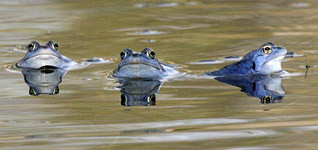
Male Moor Frog
Some amphibians “adorn” themselves for breeding season.
For example, common frogs gain blue shirtfronts, moor frogs (Rana arvalis) — silver-blue jerkins.
The attires of newts are also magnificent.
On the back of the banded newt grows a big crest, on the sides there are silver strips bordered by dark lines on top and bottom. The attire is completed by a chic tail with spots of different colors.
The male of the smooth newt does not have so showy attire, but it can dance in front of his bride. For example, first it stands on the head and forelegs — for ten seconds! Then it begins to show acrobatic feats and “tail dance”.
In contrast to tailless amphibians, newts perform marriage rituals in silence.
Care about the Young
Edible, marsh, and common frogs, having laid eggs, leave them.
In case of moor frogs, males stay to guard the clutch. They attack anyone who approaches it! They do not leave the post until tadpoles hatch. Only then, starving fathers go to land and may eat well.
In the similar way behaves male of African bullfrog (Pyxicephalus adspersus). While the tadpoles forage together near the surface of water, the father swims nearby or among them with the head above the water. It has sharp teeth and a large size (20-25 cm long); it guards the children attacking big animals and even people who approach them.
* * *
Some amphibians of South and Central America — dart frogs (Dendrobatidae) — lay eggs not into water but hide it in the forest floor, in crevices under rocks, attach the eggs to leaves which are hanging over water. Both parents guard the eggs constantly or visit them from time to time. They also moisten the eggs with water, which they bring in the mouth.
And they carry hatched tadpoles on the back. Whereto? Sometimes — to natural reservoirs. Sometimes — to small pools in leaves, where rainwater gets accumulated. And both parents bring food in their mouths to the young — like birds or mammals!
* * *
The male of the Darwin frog (Rhinoderma darwini) bears the young in its body! It places the eggs, lied by the female, into its vocal pouch. Hatched tadpoles grow by their backs to the walls of the father’s vocal pouch and receive the feeding through the father’s circulatory system. After their development is completed — in this analogue of mammal’s womb! — the tadpoles lose their tails and come out through the father’s mouth.
The male of the midwife toad (Alytes obstetricans) also bears very carefully its young — not in the body, but on the thighs — it winds the eggs around its hind legs and carries them in this way for about one month, until tadpoles hatch. Then the development of tadpoles proceeds in water and lasts sometimes for more than 2 years.
* * *
Among amphibians there is a method of carrying the young analogous to marsupial mammals. The Surinam toad (Pipa pipa) carries tadpoles in a cellular “pouch” on its back.
Females of Hemiphractinae family also bears fertilized eggs in a special skin pouch on the back.
* * *
Care about the young reaches the highest degree in the case of two species of Australian toads — Southern gastric-brooding frog (Rheobatrachus silus) and Northern gastric-brooding frog (Rheobatrachus vitellinus). These species are the only ones which bears the young in the stomach. The female swallows the eggs after the male fertilizes them. Seven-eight weeks afterward, fully formed froglets come from the stomach to the mouth of the mother, sit on its tongues, and jump out from it to the outer world. It was found that tadpoles secrete special chemical substance — prostoglandin E2, which suppresses secreting of the acid by the mother’s stomach. Unfortunately, these specious may become extinct.
Why Do Tailed Amphibians Need Tails?
A tail for tailed amphibians is as important part of the body as legs for tailless amphibians. Some tailed amphibians with the help of the tail can hang on a branch or prop themselves when climbing up, or use the tail as a pushing “fifth leg” for jumping.
Some salamanders successfully use the tail for distracting the attention of predators. In case of a threat, they can break off the tail, as lizards do, and escape. The separated tail continues to wriggle distracting the attention of the predator from the escaping salamander.
Strange, but True!
Amphibians, as many other animals, are sensitive to forthcoming changes of weather. For example, even the color of frog’s skin changes: before rain it becomes of grayish shade, and before fine weather — yellowish.
What is the Importance of Amphibians for Us?
Amphibians are quite important for humans. Feeding on insects, they prevent mass multiplication of plant pests. Thanks to this, they — together with insectivorous birds — are considered as protectors of harvest, friends of gardeners. They also destroy a great number of blood-sucking insects, including carriers of human diseases, malaria mosquitoes, for example. They do it not only on land by catching adult insects: for example, the main food of newts is mosquito larvae living in water.
In the USA they estimated the resource saving in the farming and forest industry thanks to toads. It amounted to billions of dollars per year! The saving thanks to one toad is about 20-30 dollars.
In Paris, there was a market where peasants would buy hundreds of toads for placing them in their gardens and fields. By this they would save a large part of their harvests.
Amphibians amaze us by wonderful properties of their organisms and complex behavior! Among them, there are no those harmful for men, all are useful!
Let us not harm these nice creatures! Let us admire them and love them!
This section of the site was created with use of the material from sites:
http://zooclub.ru/amfib/index.shtml
http://www.terrarium1.narod.ru/papka6/index.htm
See also:
1. Akimushkin I.I. — The Animal World. Birds, Fishes, Amphibians, and Reptiles. “Mysl”, Moscow, 1989.
2. Brehm A.E. — Life of Animals. “Terra”, Moscow, 1996.
3. Knowing the World: Amphibians. “AST”, Moscow, 1998.
To enlarge any photo on the screen — click on it with mouse.
Authors of photographs: Anton Teplyy, Ekateria Smirnova, Olga Stepanets.
-2.jpg)
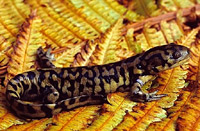
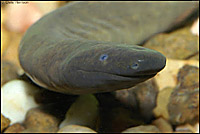
-4.jpg)
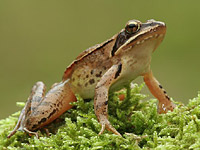
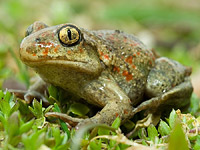
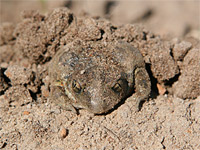
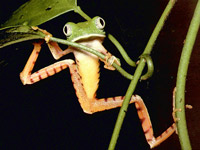
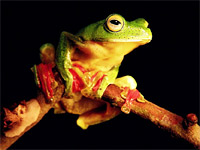
.jpg)

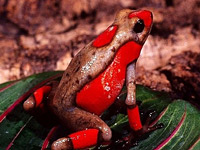
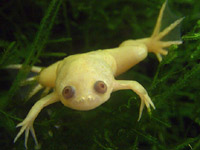
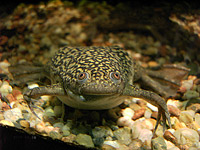

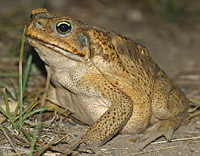
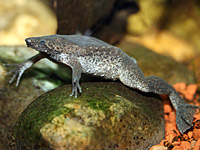
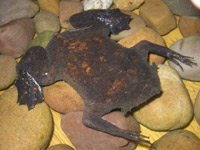
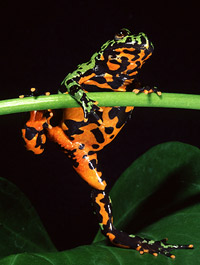
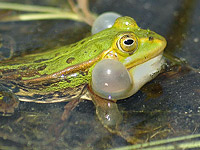
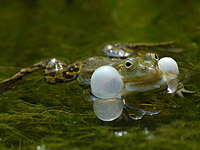
-4.jpg)
